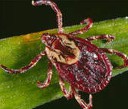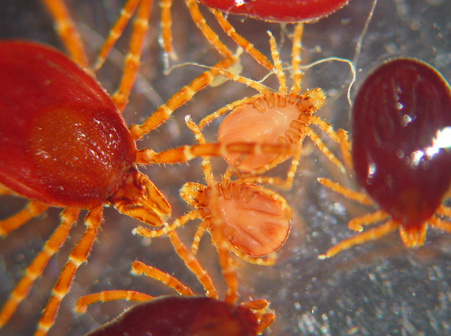Tick season is in high gear, and keeping pets and humans protected is crucial
Unlike places like Tennessee and Kentucky where ticks are always a problem, Michigan has explosions of ticks. We are in the middle of one now!
Since the beginning of May, Ann Arbor Animal Hospital has been pulling ticks off dogs, and sharing tick adventures of ourselves and families. We expect this tick bloom to last from mid April through early July. Walking our family dog Maddie in Saginaw Forest, a University of Michigan property west of Ann Arbor on the north side of Liberty Road, has resulted in ticks on the dog, ticks crawling on the car seats, and ticks scampering on my hat and ears and attached to me.
The grooming facility in our building, Groom and Go, has been removing many ticks from dogs coming for grooming. Ticks can and do attach to cats, but my experience so far this year is seeing ticks on dogs only.

​Protection and avoidance for people: Wear light color clothing, long pants, socks and closed shoes. Keep on paved or mowed walkways. Avoid sitting or lying on the ground. Inspect yourself, and your companions for ticks moving on clothing or attached. Ticks seem to prefer the head and ears, but can attach anywhere. Outdoor stores sell hats and other garments impregnated with repellants that may decrease the numbers of ticks trying to climb onto humans.
Protection for dogs: None of the oral monthly heartworm preventives will repel or kill ticks. Effective safe tick control includes topicals like Frontline and Vectra, and tick collar called Scalibor.
Protection for cats: My very favorite topical flea, heartworm, roundworm and ear mite preventive for cats, Revolution, is only partially protective for ticks. If you find and remove a tick from a cat with outdoor exposure, I recommend using Revolution for monthly multiparasite control and a second topical, Frontline two weeks later as additional tick protection.
These two products can safely be used on the same animal in this manner. In areas of the country like the Gulf coast where Cytauxzoonosis is a problem, every outdoor cat needs tick protection with Frontline year round.
Tick removal: Check your dogs daily. The goal is to remove the entire tick whole. Usually a tiny piece of skin will be pulled off in the tick’s mouth. Blunt tweezers, a special plastic scooping tick remover, or fingers all will work. Wear gloves to prevent exposure to the blood or tick fluids. The site of tick removal may have a firm, somewhat itchy swelling for weeks after tick has been removed.
Ticks large and small: Larval and nymph ticks have three pairs of legs, and are quite small, one to two millimeters in length. Adult ticks are larger, with four pairs of legs. Ticks swell with feeding. Engorged females may be a pink to pale gray, a smooth glob eight to 15 mm, and larger than a pea, while male ticks remain flat, about five mm wide.

Ticks are vectors for diseases: Lyme disease is common in the upper peninsula of Michigan, Wisconsin, and the entire east coast. It can occur in Washtenaw County. Deer ticks, the vector for Lyme, are a small tick, and are present in this area. You can find out some additional information by watching this Tick Prevalence video produced by the Companion Animal Parasite Council.
Ehrlichiosis and Anaplasmosis are two tick transmitted diseases of dogs. Rocky Mountain spotted fever is also transmitted by ticks.
I do not recommend automatic treatment with antibiotics for each dog that has had a tick removed.
Now is the time to discuss tick preventive strategy and the need for tick transmitted disease treatment with your veterinarian.
Dr. Jess Franklin specializes in geriatric medicine, acupuncture, ultrasound and managing chronic disease at Ann Arbor Animal Hospital.


Comments
Soft Paw
Thu, Jun 13, 2013 : 1:13 p.m.
I never found revolution to be very effective for ear mites either.
DJBudSonic
Fri, May 31, 2013 : 1:48 a.m.
Do ticks like chickens? I came back from my chicken farm with a tick on my shirt, wondered if it was from working on the property or from the chicken area. Anybody know?
robertfestinger
Tue, May 28, 2013 : 9:12 a.m.
Hi, Actually you have to check fleas manually, if your dog have fleas you can find out, and use flea and tick killer product to remove it like Generic Frontline plus or frontline plus
RunsWithScissors
Thu, May 23, 2013 : 3:23 p.m.
Questions: If you use Frontline on your dog, do you still need to do an inspection for ticks? Is this a methodical way of looking for ticks? I have a large dog with brown curly hair; finding ticks on him is like looking for hay in a haystack. Tick season is supposedly over by early July. Is that because they're done breeding and have gone away or is it more of a temperature thing?
PhillyCheeseSteak
Thu, May 23, 2013 : 11:56 a.m.
My family found 6 ticks on our dog after a recent walk in the woods.
LexVet
Thu, May 23, 2013 : 1:32 a.m.
It is important to note that in order for Frontline to work, the tick must first bite. On average, it takes about a day for the tick to die after biting/attaching to your pet. This is better than no protection, but 24 hours is plenty of time for most of the tick borne diseases to be transmitted. There are other (newer) products that are fully approved and available through your veterinarian that begin to work on contact by paralyzing the mouth parts of the tick- no biting necessary. These products are also topical, and applied monthly.
IdentifyUS
Wed, May 22, 2013 : 3:36 p.m.
Finding and promptly removing ticks (from a person or pet) can, indeed, dramatically reduce risk of infection or other health burden (such as tick paralysis). Once the tick has been removed, have it identified. Only certain kinds of ticks can transmit the agents of Lyme disease, babesiosis and anaplasmosis. Other ticks may transmit other infections. The longer the tick is attached, the greater the risk of infection. Physical samples can be sent, or digital images uploaded, for a rapid, confidential, independent and expert evaluation. The results can then better inform decisions by the health professional and client. For more educational information, guidance on tick removal and help with identification, visit https://identify.us.com/idmybug/ticks/tick-FAQS/